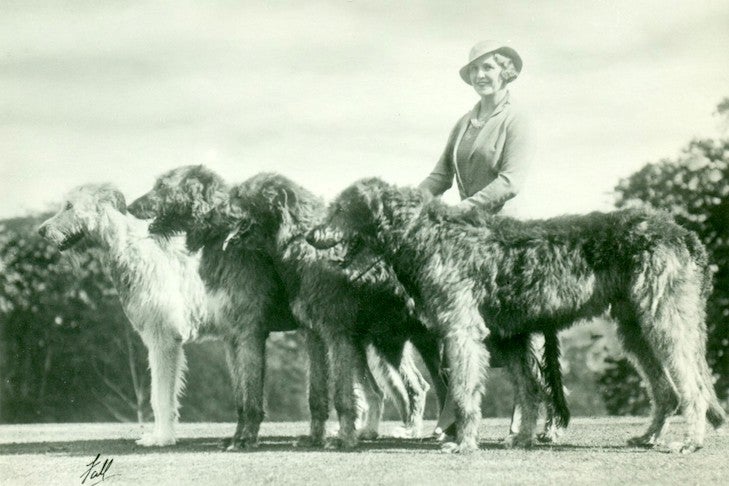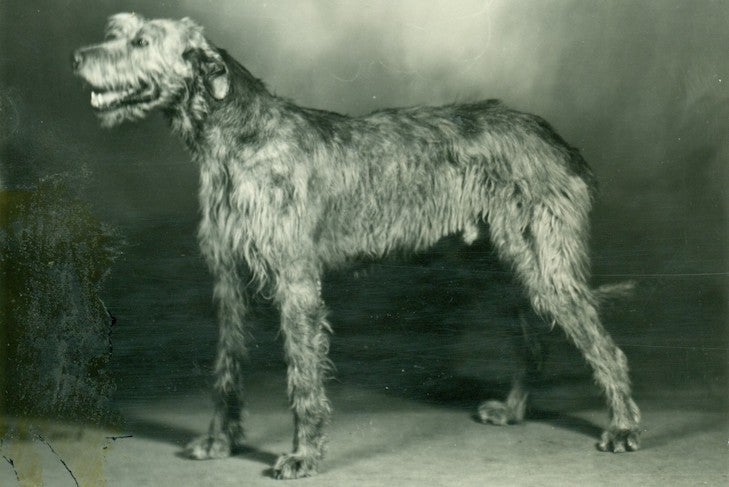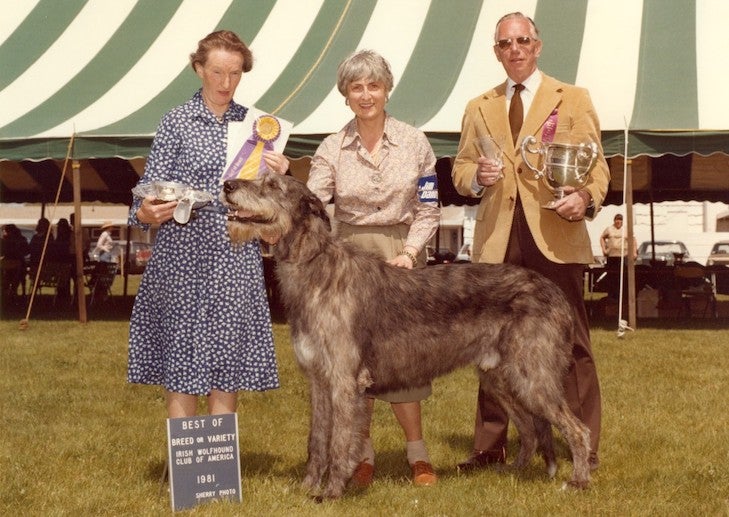
There is such a thing as being too good at your job.
Just ask the Irish Wolfhound.
As far back as Roman times, there were accounts of large Greyhound-like dogs in Ireland – called cú faoil in ancient Gaelic – revered for their size and ferocity. Some Irish chieftains and warriors even grafted the word cú onto their own names as an honorific, signifying that they were as venerable and loyal as the dogs themselves.
Like many Sighthounds of the time-misted past, ownership of these dogs was reserved for the high born. Over the centuries, they became coveted gifts to emperors and ambassadors, kings and cardinals, often arriving in ancient times in symbolic groups of seven, tied with silver chains.
Ancient Irish Hounds
In 391 AD, the Roman statesman Quintus Aurelius Symmachus wrote a letter of thanks to his brother for the gift of seven Irish hounds, noting that “all Rome viewed them in wonder.” And from two millennia ago comes the story of Ailbé, so famous that two kings vied to own him, one offering “three score hundred milch cows at once and a chariot with two horses and as much again at the end of the year.” When the bidding war escalated into an actual one, Ailbé literally lost his head after attacking one of the king’s chariots and seizing its axle. Even beheaded, he hung on.
As those ancient – and arguably a bit inflated – anecdotes show, these imposing Irish dogs were prized in battle. Guardians of property and livestock, they also hunted deer, elk, boar, and – as their modern name attests – wolves.
The Irish people “are not without wolves and greyhounds to hunt them, bigger of bone and limb than a colt,” wrote Edmund Campion in his “Historie of Ireland” in 1571. So popular were the dogs overseas that in 1652 Oliver Cromwell issued a declaration prohibiting their exportation.

Folklore and Fate
The breed’s prowess in dispatching wolves and its unshakeable character are intertwined in the heart-rending story of Gelert, an Irish hound gifted to Llewellyn, the prince of Wales, by King John of England in 1210. Returning to his castle from a hunt in which Gelert was conspicuously absent, Llewellyn found the dog covered in blood, and his infant son’s cradle overturned and empty. Presuming Gelert had savaged the boy, Llewellyn plunged his sword into the dog’s side. As Gelert howled in his death throes, Llewellyn heard another source of wailing – his son, crawling out from under a pile of swaddling. Nearby was the dead wolf that had intended the same fate for the boy, but was pre-empted by the now-dying hound.
While some maintain that the story of Gelert was fabricated by an innkeeper who wanted to improve foot traffic, the veracity of the tale almost doesn’t matter. It embodies the strong and sentimental attachment that the Irish long had to their native hound.
But neither royal fiat nor flowery folklore could do much about the fate of Ireland’s ancient wolf dog. After the last wolf in Ireland reportedly met his end in 1786, the dogs themselves soon followed suit. By 1836, the breed was included on a list entitled “Notices of Animals which have disappeared from Ireland.”
Reviving the Irish Wolfhound
A quarter-century later, in 1863, Captain George Augustus Graham decided to revive the Irish Wolfhound. Initially a Deerhound enthusiast, Graham acquired some dogs descended from those of fellow Scotsman H.D. Richardson, who decades earlier had scoured the Irish countryside for dogs purportedly descended from the surviving strains of old Irish hounds. Experts argue over whether these pedigree-less dogs had any connection to the famed wolf-dogs of yore, but regardless, they were not basis enough to build a breed. To augment his stock, Graham used Scottish Deerhounds and Great Dane crosses, which provided the size and especially heavy bone that the more ethereal Deerhounds lacked.
Graham also incorporated a bit of Borzoi blood, specifically that of “Korotai,” owned by the Duchess of Newcastle. There was a one-time cross to a Tibetan Mastiff named Wolf, which some believe was actually a rare Kyi Apso, a smaller, bearded version of those native Tibetan dogs; two of Wolf’s daughters, Vandal and Nookoo, are behind every Irish Wolfhound alive today. And a well-known Mastiff of the period, Garnier’s Lion, also made it into Wolfhound pedigrees through offspring he produced with a Scottish Deerhound named Lufra.
Even if he believed that the dogs he was breeding had a connection, however tenuous, to the old Irish hound, Graham acknowledged they lacked the “original integrity” of their forebears. To illustrate the goal he was breeding toward, Graham commissioned a local artist to paint a life-size cardboard model of his ideal Irish Wolfhound. Painted gray, it measured 35 inches at the shoulder, with a girth that Graham estimated at some 42 inches and a weight of 140 pounds.
“It presents to the vision a most striking and remarkable animal of a very majestic and beautiful appearance,” Graham mused with satisfaction, “far, far beyond any dog the writer has ever seen.”

The Modern Irish Wolfhound
The model has long since been scrapped, but a photograph of Graham posing with it survives. The two-dimensional dog looks for all the world like a modern Irish Wolfhound, with the requisite mass and substance, but still retaining its flowing, Greyhound-like lines – an important point to remember in a breed where the emphasis is sometimes placed exclusively on sheer size.
Graham himself was wary of putting such a premium on size that it eclipsed all else. “An all-round sound dog of medium height is far preferable to an overgrown badly-shaped, crooked-legged giant; for size, though most important, cannot in any way make up for unsoundness,” he wrote in the “Kennel Encyclopaedia” in 1907.
During Graham’s time, dogs could be shown even if their breed was not officially recognized by the kennel club. Irish Wolfhounds bowed in 1879 at a dog show in Dublin, then again in 1881 in England, where they were registered under “Foreign Breeds.” Demonstrating the fluidity of the situation in the breed’s early years, some of those first Irish Wolfhounds had previously been exhibited as Deerhounds, or had littermates that were.
By 1885, the breed was stable enough that Graham and others founded the Irish Wolfhound Club, writing an official standard the following year.
Today, the Irish Wolfhound has stayed true to Graham’s vision, having evolved into a powerful yet swift breed that could never be mistaken for any other. While scholars still argue whether Graham simply revived a fading breed, or manufactured a new one, one thing is for certain: In its current occupation as a beloved companion, the Irish Wolfhound has no need to fear another brush with extinction.

